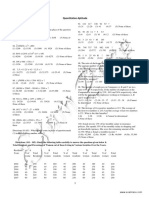PHP 5 and Mysql Database
Uploaded by
Ako CSir ArtBeracutePHP 5 and Mysql Database
Uploaded by
Ako CSir ArtBeracuteMysql and Php
PHP Connect to the MySQL Server
1) PHP Create Database and Tables
a)
Create a Table
b)
Create a Database
2) Php Mysql Insert into
3)
PHP Mysql Select
4)
PHP MySQL The Where Clause
5)
PHP MySQL The Where Clause
6)
PHP MySQL Order By Keyword
7)
PHP MySQL Update
8)
PHP MySQL Delete
9)
PHP Database ODBC
1:
Mysql and Php
2:
PHP MySQL Introduction
With PHP, you can connect to and manipulate databases.
MySQL is the most popular database system used with PHP.
What is MySQL?
MySQL
MySQL
MySQL
MySQL
MySQL
MySQL
MySQL
MySQL
MySQL
is a database system used on the web
is a database system that runs on a server
is ideal for both small and large applications
is very fast, reliable, and easy to use
supports standard SQL
compiles on a number of platforms
is free to download and use
is developed, distributed, and supported by Oracle Corporation
is named after co-founder Monty Widenius's daughter: My
The data in MySQL is stored in tables. A table is a collection of related data, and it consists of columns and
rows.
Databases are useful when storing information categorically. A company may have a database with the
following tables:
Employees
Products
Customers
Orders
PHP + MySQL
PHP combined with MySQL are cross-platform (you can develop in Windows and serve on a Unix
platform)
Queries
A query is a question or a request.
We can query a database for specific information and have a recordset returned.
Look at the following query (using standard SQL):
Mysql and Php
SELECT LastName FROM Employees
The query above selects all the data in the "LastName" column from the "Employees" table.
To learn more about SQL, please visit our SQL tutorial.
Download MySQL Database
If you don't have a PHP server with a MySQL Database, you can download MySQL for free
here:http://www.mysql.com
Facts About MySQL Database
One great thing about MySQL is that it can be scaled down to support embedded database applications.
Maybe it is because of this many people think that MySQL can only handle small and medium-sized
systems.
The truth is that MySQL is the de-facto standard database system for web sites with HUGE volumes of
both data and end users (like Friendster, Yahoo, and Google).
Look at http://www.mysql.com/customers/ for an overview of companies using MySQL.
PHP Connect to the MySQL Server
Use the PHP mysqli_connect() function to open a new connection to the MySQL server.
Open a Connection to the MySQL Server
Before we can access data in a database, we must open a connection to the MySQL server.
In PHP, this is done with the mysqli_connect() function.
Syntax
mysqli_connect(host,username,password,dbname);
Parameter
Description
3:
Mysql and Php
host
Optional. Either a host name or an IP address
username
Optional. The MySQL user name
password
Optional. The password to log in with
dbname
Optional. The default database to be used when performing queries
Note: There are more available parameters, but the ones listed above are the most important.
In the following example we store the connection in a variable ($con) for later use in the script:
<?php
// Create connection
$con=mysqli_connect("example.com","peter","abc123","my_db");
// Check connection
if (mysqli_connect_errno()) {
echo "Failed to connect to MySQL: " . mysqli_connect_error();
}
?>
Close a Connection
The connection will be closed automatically when the script ends. To close the connection before, use the
mysqli_close() function:
<?php
$con=mysqli_connect("example.com","peter","abc123","my_db");
// Check connection
if (mysqli_connect_errno()) {
echo "Failed to connect to MySQL: " . mysqli_connect_error();
}
mysqli_close($con);
?>
4:
Mysql and Php
PHP Create Database and Tables
A database holds one or more tables.
Create a Database
The CREATE DATABASE statement is used to create a database in MySQL.
We must add the CREATE DATABASE statement to the mysqli_query() function to execute the command.
The following example creates a database named "my_db":
<?php
$con=mysqli_connect("example.com","peter","abc123");
// Check connection
if (mysqli_connect_errno()) {
echo "Failed to connect to MySQL: " . mysqli_connect_error();
}
// Create database
$sql="CREATE DATABASE my_db";
if (mysqli_query($con,$sql)) {
echo "Database my_db created successfully";
} else {
echo "Error creating database: " . mysqli_error($con);
}
?>
Create a Table
The CREATE TABLE statement is used to create a table in MySQL.
We must add the CREATE TABLE statement to the mysqli_query() function to execute the command.
5:
Mysql and Php
6:
The following example creates a table named "Persons", with three columns: "FirstName", "LastName"
and "Age":
<?php
$con=mysqli_connect("example.com","peter","abc123","my_db");
// Check connection
if (mysqli_connect_errno()) {
echo "Failed to connect to MySQL: " . mysqli_connect_error();
}
// Create table
$sql="CREATE TABLE Persons(FirstName CHAR(30),LastName CHAR(30),Age INT)";
// Execute query
if (mysqli_query($con,$sql)) {
echo "Table persons created successfully";
} else {
echo "Error creating table: " . mysqli_error($con);
}
?>
Note: When you create a field of type CHAR, you must specify the maximum length of the field, e.g.
CHAR(50).
The data type specifies what type of data the column can hold. For a complete reference of all the data
types available in MySQL, go to our complete Data Types reference.
Primary Keys and Auto Increment Fields
Each table in a database should have a primary key field.
A primary key is used to uniquely identify the rows in a table. Each primary key value must be unique
within the table. Furthermore, the primary key field cannot be null because the database engine requires a
value to locate the record.
The following example sets the PID field as the primary key field. The primary key field is often an ID
number, and is often used with the AUTO_INCREMENT setting. AUTO_INCREMENT automatically increases
the value of the field by 1 each time a new record is added. To ensure that the primary key field cannot be
null, we must add the NOT NULL setting to the field:
$sql = "CREATE TABLE Persons
(
PID INT NOT NULL AUTO_INCREMENT,
PRIMARY KEY(PID),
FirstName CHAR(15),
LastName CHAR(15),
Mysql and Php
Age INT
)";
PHP MySQL Insert Into
The INSERT INTO statement is used to insert new records in a table.
Insert Data Into a Database Table
The INSERT INTO statement is used to add new records to a database table.
Syntax
It is possible to write the INSERT INTO statement in two forms.
The first form doesn't specify the column names where the data will be inserted, only their values:
INSERT INTO table_name
VALUES (value1, value2, value3,...)
The second form specifies both the column names and the values to be inserted:
INSERT INTO table_name (column1, column2, column3,...)
VALUES (value1, value2, value3,...)
To learn more about SQL, please visit our SQL tutorial.
To get PHP to execute the statements above we must use the mysqli_query() function. This function is
used to send a query or command to a MySQL connection.
Example
In the previous chapter we created a table named "Persons", with three columns; "FirstName",
"LastName" and "Age". We will use the same table in this example. The following example adds two new
records to the "Persons" table:
<?php
$con=mysqli_connect("example.com","peter","abc123","my_db");
// Check connection
if (mysqli_connect_errno()) {
echo "Failed to connect to MySQL: " . mysqli_connect_error();
}
mysqli_query($con,"INSERT INTO Persons (FirstName, LastName, Age)
7:
Mysql and Php
8:
VALUES ('Peter', 'Griffin',35)");
mysqli_query($con,"INSERT INTO Persons (FirstName, LastName, Age)
VALUES ('Glenn', 'Quagmire',33)");
mysqli_close($con);
?>
Insert Data From a Form Into a Database
Now we will create an HTML form that can be used to add new records to the "Persons" table.
Here is the HTML form:
<html>
<body>
<form action="insert.php" method="post">
Firstname: <input type="text" name="firstname">
Lastname: <input type="text" name="lastname">
Age: <input type="text" name="age">
<input type="submit">
</form>
</body>
</html>
When a user clicks the submit button in the HTML form, in the example above, the form data is sent to
"insert.php".
The "insert.php" file connects to a database, and retrieves the values from the form with the PHP $_POST
variables.
The mysqli_real_escape_string() function escapes special characters in a string for security against SQL
injection.
Then, the mysqli_query() function executes the INSERT INTO statement, and a new record will be added
to the "Persons" table.
Here is the "insert.php" page:
<?php
$con=mysqli_connect("example.com","peter","abc123","my_db");
Mysql and Php
// Check connection
if (mysqli_connect_errno()) {
echo "Failed to connect to MySQL: " . mysqli_connect_error();
}
// escape variables for security
$firstname = mysqli_real_escape_string($con, $_POST['firstname']);
$lastname = mysqli_real_escape_string($con, $_POST['lastname']);
$age = mysqli_real_escape_string($con, $_POST['age']);
$sql="INSERT INTO Persons (FirstName, LastName, Age)
VALUES ('$firstname', '$lastname', '$age')";
if (!mysqli_query($con,$sql)) {
die('Error: ' . mysqli_error($con));
}
echo "1 record added";
mysqli_close($con);
?>
PHP MySQL Select
The SELECT statement is used to select data from a database.
Select Data From a Database Table
The SELECT statement is used to select data from a database.
Syntax
SELECT column_name(s)
FROM table_name
9:
Mysql and Php
10:
To learn more about SQL, please visit our SQL tutorial.
To get PHP to execute the statement above we must use the mysqli_query() function. This function is
used to send a query or command to a MySQL connection.
Example
The following example selects all the data stored in the "Persons" table (The * character selects all the
data in the table):
<?php
$con=mysqli_connect("example.com","peter","abc123","my_db");
// Check connection
if (mysqli_connect_errno()) {
echo "Failed to connect to MySQL: " . mysqli_connect_error();
}
$result = mysqli_query($con,"SELECT * FROM Persons");
while($row = mysqli_fetch_array($result)) {
echo $row['FirstName'] . " " . $row['LastName'];
echo "<br>";
}
mysqli_close($con);
?>
The example above stores the data returned by the mysqli_query() function in the $result variable.
Next, we use the mysqli_fetch_array() function to return the first row from the recordset as an array.
Each call to mysqli_fetch_array() returns the next row in the recordset. The while loop loops through all
the records in the recordset. To print the value of each row, we use the PHP $row variable
($row['FirstName'] and $row['LastName']).
The output of the code above will be:
Peter Griffin
Glenn Quagmire
Display the Result in an HTML Table
The following example selects the same data as the example above, but will display the data in an HTML
table:
Mysql and Php
<?php
$con=mysqli_connect("example.com","peter","abc123","my_db");
// Check connection
if (mysqli_connect_errno()) {
echo "Failed to connect to MySQL: " . mysqli_connect_error();
}
$result = mysqli_query($con,"SELECT * FROM Persons");
echo "<table border='1'>
<tr>
<th>Firstname</th>
<th>Lastname</th>
</tr>";
while($row = mysqli_fetch_array($result)) {
echo "<tr>";
echo "<td>" . $row['FirstName'] . "</td>";
echo "<td>" . $row['LastName'] . "</td>";
echo "</tr>";
}
echo "</table>";
mysqli_close($con);
?>
The output of the code above will be:
Firstname Lastname
Glenn
Quagmire
Peter
Griffin
PHP MySQL The Where Clause
The WHERE clause is used to filter records.
11:
Mysql and Php
The WHERE clause
The WHERE clause is used to extract only those records that fulfill a specified criterion.
Syntax
SELECT column_name(s)
FROM table_name
WHERE column_name operator value
To learn more about SQL, please visit our SQL tutorial.
To get PHP to execute the statement above we must use the mysqli_query() function. This function is
used to send a query or command to a MySQL connection.
Example
The following example selects all rows from the "Persons" table where "FirstName='Peter'":
<?php
$con=mysqli_connect("example.com","peter","abc123","my_db");
// Check connection
if (mysqli_connect_errno()) {
echo "Failed to connect to MySQL: " . mysqli_connect_error();
}
$result = mysqli_query($con,"SELECT * FROM Persons
WHERE FirstName='Peter'");
while($row = mysqli_fetch_array($result)) {
echo $row['FirstName'] . " " . $row['LastName'];
echo "<br>";
}
?>
The output of the code above will be:
Peter Griffin
PHP MySQL Order By Keyword
The ORDER BY keyword is used to sort the data in a recordset.
12:
Mysql and Php
13:
The ORDER BY Keyword
The ORDER BY keyword is used to sort the data in a recordset.
The ORDER BY keyword sort the records in ascending order by default.
If you want to sort the records in a descending order, you can use the DESC keyword.
Syntax
SELECT column_name(s)
FROM table_name
ORDER BY column_name(s) ASC|DESC
To learn more about SQL, please visit our SQL tutorial.
Example
The following example selects all the data stored in the "Persons" table, and sorts the result by the "Age"
column:
<?php
$con=mysqli_connect("example.com","peter","abc123","my_db");
// Check connection
if (mysqli_connect_errno()) {
echo "Failed to connect to MySQL: " . mysqli_connect_error();
}
$result = mysqli_query($con,"SELECT * FROM Persons ORDER BY age");
while($row = mysqli_fetch_array($result)) {
echo $row['FirstName'];
echo " " . $row['LastName'];
echo " " . $row['Age'];
echo "<br>";
}
mysqli_close($con);
?>
The output of the code above will be:
Glenn Quagmire 33
Peter Griffin 35
14:
Mysql and Php
Order by Two Columns
It is also possible to order by more than one column. When ordering by more than one column, the
second column is only used if the values in the first column are equal:
SELECT column_name(s)
FROM table_name
ORDER BY column1, column2
PHP MySQL Update
The UPDATE statement is used to modify data in a table.
Update Data In a Database
The UPDATE statement is used to update existing records in a table.
Syntax
UPDATE table_name
SET column1=value, column2=value2,...
WHERE some_column=some_value
Note: Notice the WHERE clause in the UPDATE syntax. The WHERE clause specifies which record or
records that should be updated. If you omit the WHERE clause, all records will be updated!
To learn more about SQL, please visit our SQL tutorial.
To get PHP to execute the statement above we must use the mysqli_query() function. This function is
used to send a query or command to a MySQL connection.
Example
Earlier in the tutorial we created a table named "Persons". Here is how it looks:
FirstName
LastName
Age
Peter
Griffin
35
Glenn
Quagmire
33
The following example updates some data in the "Persons" table:
Mysql and Php
<?php
$con=mysqli_connect("example.com","peter","abc123","my_db");
// Check connection
if (mysqli_connect_errno()) {
echo "Failed to connect to MySQL: " . mysqli_connect_error();
}
mysqli_query($con,"UPDATE Persons SET Age=36
WHERE FirstName='Peter' AND LastName='Griffin'");
mysqli_close($con);
?>
After the update, the "Persons" table will look like this:
FirstName
LastName
Age
Peter
Griffin
36
Glenn
Quagmire
33
PHP MySQL Delete
The DELETE statement is used to delete records in a table.
Delete Data In a Database
The DELETE FROM statement is used to delete records from a database table.
Syntax
DELETE FROM table_name
WHERE some_column = some_value
Note: Notice the WHERE clause in the DELETE syntax. The WHERE clause specifies which record or
records that should be deleted. If you omit the WHERE clause, all records will be deleted!
To learn more about SQL, please visit our SQL tutorial.
To get PHP to execute the statement above we must use the mysqli_query() function. This function is
used to send a query or command to a MySQL connection.
15:
Mysql and Php
16:
Example
Look at the following "Persons" table:
FirstName
LastName
Age
Peter
Griffin
35
Glenn
Quagmire
33
The following example deletes all the records in the "Persons" table where LastName='Griffin':
<?php
$con=mysqli_connect("example.com","peter","abc123","my_db");
// Check connection
if (mysqli_connect_errno()) {
echo "Failed to connect to MySQL: " . mysqli_connect_error();
}
mysqli_query($con,"DELETE FROM Persons WHERE LastName='Griffin'");
mysqli_close($con);
?>
After the deletion, the table will look like this:
FirstName
LastName
Age
Glenn
Quagmire
33
PHP Database ODBC
ODBC is an Application Programming Interface (API) that allows you to connect to a data source (e.g.
an MS Access database).
Mysql and Php
17:
Create an ODBC Connection
With an ODBC connection, you can connect to any database, on any computer in your network, as long as
an ODBC connection is available.
Here is how to create an ODBC connection to a MS Access Database:
1.
2.
3.
4.
5.
6.
7.
8.
Open the Administrative Tools icon in your Control Panel.
Double-click on the Data Sources (ODBC) icon inside.
Choose the System DSN tab.
Click on Add in the System DSN tab.
Select the Microsoft Access Driver. Click Finish.
In the next screen, click Select to locate the database.
Give the database a Data Source Name (DSN).
Click OK.
Note that this configuration has to be done on the computer where your web site is located. If you are
running Internet Information Server (IIS) on your own computer, the instructions above will work, but if
your web site is located on a remote server, you have to have physical access to that server, or ask your
web host to to set up a DSN for you to use.
Connecting to an ODBC
The odbc_connect() function is used to connect to an ODBC data source. The function takes four
parameters: the data source name, username, password, and an optional cursor type.
The odbc_exec() function is used to execute an SQL statement.
Example
The following example creates a connection to a DSN called northwind, with no username and no
password. It then creates an SQL and executes it:
$conn=odbc_connect('northwind','','');
$sql="SELECT * FROM customers";
$rs=odbc_exec($conn,$sql);
Retrieving Records
The odbc_fetch_row() function is used to return records from the result-set. This function returns true if it
is able to return rows, otherwise false.
Mysql and Php
18:
The function takes two parameters: the ODBC result identifier and an optional row number:
odbc_fetch_row($rs)
Retrieving Fields from a Record
The odbc_result() function is used to read fields from a record. This function takes two parameters: the
ODBC result identifier and a field number or name.
The code line below returns the value of the first field from the record:
$compname=odbc_result($rs,1);
The code line below returns the value of a field called "CompanyName":
$compname=odbc_result($rs,"CompanyName");
Closing an ODBC Connection
The odbc_close() function is used to close an ODBC connection.
odbc_close($conn);
An ODBC Example
The following example shows how to first create a database connection, then a result-set, and then
display the data in an HTML table.
<html>
<body>
<?php
$conn=odbc_connect('northwind','','');
if (!$conn) {
exit("Connection Failed: " . $conn);
}
Mysql and Php
$sql="SELECT * FROM customers";
$rs=odbc_exec($conn,$sql);
if (!$rs) {
exit("Error in SQL");
}
echo "<table><tr>";
echo "<th>Companyname</th>";
echo "<th>Contactname</th></tr>";
while (odbc_fetch_row($rs)) {
$compname=odbc_result($rs,"CompanyName");
$conname=odbc_result($rs,"ContactName");
echo "<tr><td>$compname</td>";
echo "<td>$conname</td></tr>";
}
odbc_close($conn);
echo "</table>";
?>
</body></html>
19:
You might also like
- Build A CMS in An Afternoon With PHP and MySQL100% (1)Build A CMS in An Afternoon With PHP and MySQL45 pages
- Service Manuals LG TV LCD 42LG61YD 42LG61YD Service ManualNo ratings yetService Manuals LG TV LCD 42LG61YD 42LG61YD Service Manual45 pages
- PHP Database Connections Using MySQLi and PDONo ratings yetPHP Database Connections Using MySQLi and PDO8 pages
- PHP Database Open A Connection To The Mysql Server: SyntaxNo ratings yetPHP Database Open A Connection To The Mysql Server: Syntax13 pages
- 16 Lectures On MYSQL DATABASE StatementsNo ratings yet16 Lectures On MYSQL DATABASE Statements16 pages
- Create A Connection To A Mysql Database: SyntaxNo ratings yetCreate A Connection To A Mysql Database: Syntax10 pages
- Create Mysql Database and Table Using PHP in Xampp: PrerequisitesNo ratings yetCreate Mysql Database and Table Using PHP in Xampp: Prerequisites55 pages
- (Developer Shed Network) Server Side - PHP - PHP 101 (Part 4) - Look, Ma... It's Alive!No ratings yet(Developer Shed Network) Server Side - PHP - PHP 101 (Part 4) - Look, Ma... It's Alive!17 pages
- How To Build A Simple REST API in PHP - Envato Tuts+No ratings yetHow To Build A Simple REST API in PHP - Envato Tuts+17 pages
- Insert Data Into MySQL Database Using Jquery AJAX PHP100% (1)Insert Data Into MySQL Database Using Jquery AJAX PHP7 pages
- How To Connect HTML To Database With MySQL Using PHPNo ratings yetHow To Connect HTML To Database With MySQL Using PHP15 pages
- Loadlined Split Hulled Dump Scow, 1450 Cy: SpecificationsNo ratings yetLoadlined Split Hulled Dump Scow, 1450 Cy: Specifications1 page
- Wireless Installation Guide L575/L655/L656No ratings yetWireless Installation Guide L575/L655/L65650 pages
- Wireless Installation Guide L575/L655/L656No ratings yetWireless Installation Guide L575/L655/L65650 pages
- Quantitative Aptitude Sample Paper 1 PDFNo ratings yetQuantitative Aptitude Sample Paper 1 PDF9 pages
- CURRICULUM MAP FOR BACHELOR OF ELEMENTARY EDUCATIONNo ratings yetCURRICULUM MAP FOR BACHELOR OF ELEMENTARY EDUCATION6 pages
- Airbus A350 Firm Orders: Commandes Fermes - FESTBESTELLUNGEN - Pedidos en FirmeNo ratings yetAirbus A350 Firm Orders: Commandes Fermes - FESTBESTELLUNGEN - Pedidos en Firme2 pages
- Typhoon Yolanda: An Analysis On The Impact of Natural Disasters and Effectiveness of Disaster ManagementNo ratings yetTyphoon Yolanda: An Analysis On The Impact of Natural Disasters and Effectiveness of Disaster Management7 pages
- Sample Social Media Policy For EmployersNo ratings yetSample Social Media Policy For Employers3 pages
- USA V Kevin Seefried Sentencing Memo by USANo ratings yetUSA V Kevin Seefried Sentencing Memo by USA42 pages
- Blockchain: Research and Applications: Lodovica Marchesi, Michele Marchesi, Roberto Tonelli, Maria Ilaria LunesuNo ratings yetBlockchain: Research and Applications: Lodovica Marchesi, Michele Marchesi, Roberto Tonelli, Maria Ilaria Lunesu13 pages
- Service Manuals LG TV LCD 42LG61YD 42LG61YD Service ManualService Manuals LG TV LCD 42LG61YD 42LG61YD Service Manual
- PHP Database Open A Connection To The Mysql Server: SyntaxPHP Database Open A Connection To The Mysql Server: Syntax
- Create Mysql Database and Table Using PHP in Xampp: PrerequisitesCreate Mysql Database and Table Using PHP in Xampp: Prerequisites
- (Developer Shed Network) Server Side - PHP - PHP 101 (Part 4) - Look, Ma... It's Alive!(Developer Shed Network) Server Side - PHP - PHP 101 (Part 4) - Look, Ma... It's Alive!
- How To Build A Simple REST API in PHP - Envato Tuts+How To Build A Simple REST API in PHP - Envato Tuts+
- Insert Data Into MySQL Database Using Jquery AJAX PHPInsert Data Into MySQL Database Using Jquery AJAX PHP
- How To Connect HTML To Database With MySQL Using PHPHow To Connect HTML To Database With MySQL Using PHP
- Loadlined Split Hulled Dump Scow, 1450 Cy: SpecificationsLoadlined Split Hulled Dump Scow, 1450 Cy: Specifications
- CURRICULUM MAP FOR BACHELOR OF ELEMENTARY EDUCATIONCURRICULUM MAP FOR BACHELOR OF ELEMENTARY EDUCATION
- Airbus A350 Firm Orders: Commandes Fermes - FESTBESTELLUNGEN - Pedidos en FirmeAirbus A350 Firm Orders: Commandes Fermes - FESTBESTELLUNGEN - Pedidos en Firme
- Typhoon Yolanda: An Analysis On The Impact of Natural Disasters and Effectiveness of Disaster ManagementTyphoon Yolanda: An Analysis On The Impact of Natural Disasters and Effectiveness of Disaster Management
- Blockchain: Research and Applications: Lodovica Marchesi, Michele Marchesi, Roberto Tonelli, Maria Ilaria LunesuBlockchain: Research and Applications: Lodovica Marchesi, Michele Marchesi, Roberto Tonelli, Maria Ilaria Lunesu






























































































